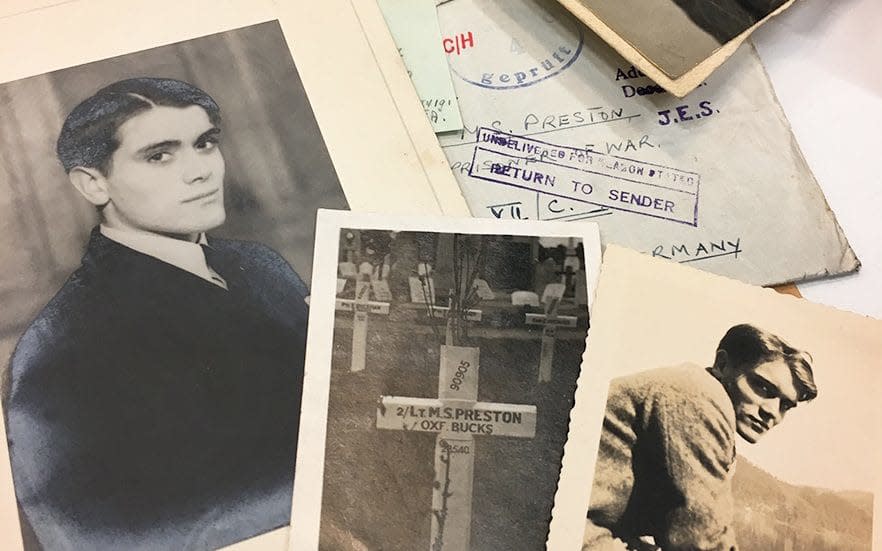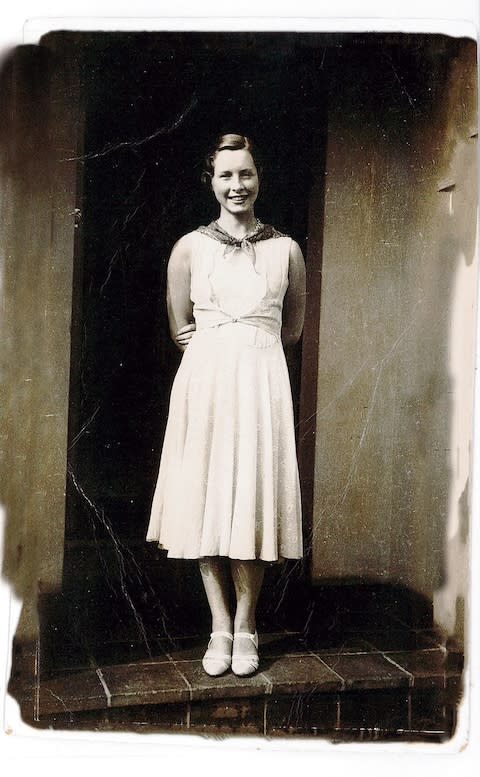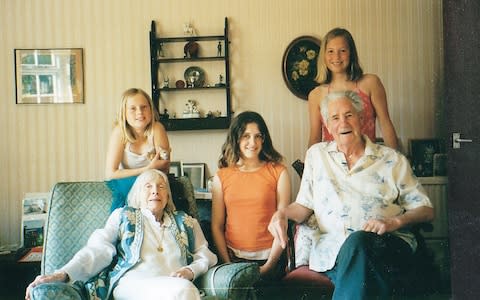'The day I found a box of letters that revealed a secret love affair my mother had hidden for 80 years'

It is almost 60 years ago, but the memory of that summer afternoon in the garden of a house in Buckinghamshire still shines in my mind, as if it were yesterday. Whichert House was named after the local word for ‘white earth’, the mixture of lime and straw used in the construction of houses in this part of the county.
It was built in the 1920s by Charles Preston, a lawyer, and it was his widow, Aunt Dorothy, as my mother called her, though we were not related by blood, whom we were visiting that day. I was nine years old.
Childhood memories have no background, only a foreground. So when I close my eyes I don’t see the house, just pools of blue shadow; a circle of grass covered in a picnic rug; a table set with tea; and Aunt Dorothy, a birdlike creature with a gardener’s tan and cornflower-blue eyes, sitting upright in a wicker chair, with a straw hat on her head.
Even after all these years, the brief time my mother and I spent in that garden – and we would never go again – is still bathed in a special light.
Sorting through my mother’s effects after her death from Alzheimer’s in 2005, my brothers and I found a battered chocolate box, decorated with red roses, at the bottom of her wardrobe. Inside, were bundles of love letters, tightly bound with string.

No one else wanted it, so I took the box home with me, where it lay unopened for weeks. Her death was still fresh and raw. I was in my mid-50s. Divorced. Anchorless. Now motherless. Then one rainy afternoon, I untied the strings and the meaning of that afternoon became clear.
Whichert House,
September 19th 1938
Dear Aunt D,
I’ve fallen madly in love with Nancy Claire Whelan. You’ve every right to laugh when you read that, but I’m terribly happy to have found someone so fond of me, who leaves everyone else I’ve met in the cold. I’m sure you’ve seen her riding her bicycle about town. She lives down the road from you at Blythe Cottage. She is an only child –and a redhead! She was at school in Oxford so she knows it well and has also lived in France and Germany. She speaks the languages, she sings and acts, she’s intelligent, pretty…
My eyes widened. This was my mother being described. But the man writing about her was not my father. I opened more letters, trying to piece together the story that lay behind them. There were about 60 in all, mostly written from Oxford, but also from France in 1940. With them were a handful of letters returned to my mother, stamped by the British Forces Post, ‘Return To Sender: Addressee Reported Missing.’
Who was this other man? And what had happened to him? Those questions propelled me on a seven-year journey of discovery and investigation that finally took me back to Whichert House. I ransacked military archives and searched out relatives of the young man. I contacted the Red Cross for his file and travelled to France, retracing his time in the Army in the run-up to Dunkirk. Gradually, I pieced together the story.

His name was Martin Preston, and he was the nephew of the celebrated First World War poet and novelist Robert Graves. When the correspondence with my mother began he was 19 years old, a second-year student at St Edmund Hall, Oxford.
He was, by all accounts, a serious young man, perhaps because of his colonial childhood. Packed off to boarding school from Egypt at the age of six, Martin rarely saw his parents. Instead, Whichert House and Aunt D, his father’s sister-in-law, and her own family, became the fixed points of his life: the place he thought of as ‘home’. Aunt D knitted him socks, made marmalade or posted back his books to Oxford when he left them behind.
His mother, Molly Preston, an operatic woman who dabbled in the occult and liked to drape herself in pearls the size of ping-pong balls, was Robert Graves’ half-sister, from his father, Alfred Perceval Graves’ second marriage, to Amalie von Ranke. Molly made much of that ‘von’, though Martin loved to tell the story of being referred to by a stuck-up relative as ‘only a half-Graves’.
When she met Martin, Nancy Claire Whelan (my mother) was 22, a vivacious redhead with a love of theatre, dance and music. She was not upper class, like Martin, but educated at Edgbaston Grammar School. He went to Marlborough. And social tensions bubbled away beneath the surface of their relationship. ‘A tax inspector?!’ Molly exclaimed in horror upon hearing that Nancy’s father worked for the Inland Revenue.
Class didn’t matter to the young couple. It was love at first sight. ‘I don’t know how to feel when you’re around,’ Martin wrote. ‘You turn me so inside out – no one has ever done it before. You are the most exciting thing in the world…’
A family row erupted when I insisted that, along with other mementos, we should display a photograph of Martin
That love would soon be interrupted. In August 1939, less than a year after they met, Martin received his commission as a second lieutenant in the Oxfordshire and Buckinghamshire Light Infantry. He was the youngest officer in the Bucks Battalion, and after training in Sussex, the regiment shipped out to northern France in January 1940. Before he left, Nancy and Martin got engaged. Martin had the words, The Very White of Love, a reference to a favourite poem by Wrey Gardiner, engraved on their rings.
The battalion was stationed in Wahagnies, a drab mining town in the Lille area. Martin was not a natural soldier. Small, fine-boned, with an artistic temperament, he was nonetheless determined to do good by his men. And for the six months of what became known as the phoney war, he drilled them in trench-digging, marching and weaponry. And dreamed of Nancy.
‘My Only Love,’ he wrote in February 1940. ‘I am sitting in the mess, almost the last one up. If I close my eyes, I am with you again, on that blissful afternoon when we drove up to Penn and lay in each other’s arms on a rug, under the lark-filled sky. The sunlight is falling across your face. Above us, that gnarled oak tree spreads its branches…’

When the balloon finally went up on 10 May 1940, German panzers smashed through the Ardennes and Martin’s battalion was readied for action. To cut down weight for the route marches ahead, the soldiers were ordered to dispose of their personal effects. Martin had to burn more than 100 letters from Nancy, which he had carried to France in his kit bag.
The Ox and Bucks, now part of the 48th Midland Division, marched east to Waterloo, but after less than 12 hours were ordered back to the Escaut Canal, where the British Army hoped to hold the advancing Germans. The roads were chaotic as British troops collided with Belgian civilians fleeing to safety.
At the village of Gaurain-Ramecroix, the battalion was strafed by Stukas dive-bombers, killing dozens of Ox and Bucks men. A French travelling circus was also caught in the melee. The body parts of dead animals and men lay strewn across the road.
On 23 May, the 1st Bucks Battalion was ordered to Hazebrouck, an important railway junction in northern France. With the surrender of the French Army, the British Expeditionary Force was fleeing headlong towards the coast. Orders were to hold the town to the last man standing. Delaying the German panzers for even 12 hours would help the British Army make it to Dunkirk.

By 28 May, the Germans had smashed their way into the centre of Hazebrouck, while Stukas and Heinkels pounded it from the air. The remnants of the battalion were holed up in an orphanage. Most of the town was on fire. Shortly before midnight, Martin was ordered to lead a patrol to the railway station.
My mother never did find out what happened to Martin that night, though for two years she tried to piece together the narrative of his last days, writing to the Red Cross and War Office, and collating information filtering back to wives and fiancées from the surviving Bucks men, now in a POW camp in Austria. She never gave up hope he was alive, mailing letter after letter into the blue, like this one, written in November 1940:
My dearest, beloved Martin.
Although we do not yet know where you are this is the fourth letter I have written in the hope that you are in Camp IXA. I shall go on writing in case one gets through to you. I often go to Penn, to the church and the great wide views we love – on your birthday I walked for miles in the warm, high sun up there. I think of you day and night. The moment I open my eyes in the morning. And when I close them at night. Your love lifts me up. It’s a crown I wear in my heart.
Martin’s story was a family secret hiding in plain sight. Right up to my mother’s death, under the glass on her dressing table, next to pictures of my father, her three children and other relatives, she kept a faded photograph of Martin, sitting on a bench in Oxford in a blazer in 1938.
And my father? The first question everyone asks is: how did your father feel? He and my mother had met in 1946, in Prague. Some photos I recently discovered show them swimming at a lake in Bohemia, laughing and smiling, clearly in love. That was three years after the War Office had officially declared Martin dead.
By then my mother had moved on in her life. She also believed that Martin would have wanted it, as this letter, written to his sister, Roseen, in 1941, makes clear: ‘Whatever happens, I know I can never stop loving Martin. I do not have to tell you that, or how much I want to go on finding kindness and beauty in life and loving it for his sake. Tears were never any part of him and we must not let them be part of us now.’
Yet she never did fully let him go. Was it selfish of her to keep alive the memory of her first great love in such a visible way? There are some in my family who believe it was and that, by doing so, she made my father, Phillip, feel he was always playing second fiddle.

In the run-up to my mother’s memorial service in 2005, a family row erupted when I insisted that, along with other mementos of her life, we should put on display some of the letters and a photograph of Martin. ‘I want to remember Mum for her 57-year-long marriage to our father,’ my elder brother said during an Easter lunch in Somerset. ‘Not for a two-year love affair she had when she was young.’
Though I cannot know for sure, I believe my father never begrudged his wife’s lost love. He was a Special Operations Executive hero, and would have respected a fellow soldier’s memory. Martin’s story was also something I think he accepted as part of Nancy’s life before he knew her; her ‘baggage’.
He certainly didn’t speak about it to me, or any of his other children. And we never asked. Our father was the person that mattered to us and out of love for him, my mother never openly brought up the past. She was too busy, being an Army wife, travelling the world with three boisterous boys, running a home, cooking: the daily ‘train-train’, as she called it.
Untarnished by the mundane rub of marriage, Martin remained the perfect love; an ideal my father could, of course, never match
Untarnished by the mundane rub of marriage, Martin remained the perfect love; an ideal my father could, of course, never match. If they had a row, or the dark winter days had sapped her normally cheerful spirits, she would sometimes take the car and drive up to Penn for a walk.
Martin went on affecting her, and all our lives, in subtle ways, like a subterranean river flowing beneath the house. I discovered, for instance, that she lived at Whichert House after Martin’s death. And that, in the 1970s, my mother and father travelled together to Hazebrouck in Flanders so that Nancy could lay a wreath at Martin’s grave.
I did the same in 2010. And though my father’s family was from Somerset, she never strayed from Buckinghamshire, clinging, like a barnacle, to the landscape of her youth, and her first, great love. She died in 2005, five miles from Whichert House. My father followed her a year later, to the day.

As a child, I would sometimes look at the photos of this young man and wonder who he was. Did I, in some unconscious way, identify with Martin as an alternative narrative, the father I might have had? The letters in the chocolate box were a gift. Not only were they beautifully written. They also told a story that rose above the particulars of time and place: a universal tale about two young people facing the ultimate challenge of war.
Bringing my mother back to life in fiction, as a vibrant young woman, helped me forget the suffering of her final years with Alzheimer’s. And by telling the story of this brief and beautiful affair, I could rescue it from oblivion, and make good on the hope expressed in one of Martin’s letters that ‘this love can’t all be for nothing’.
The Very White of Love, by SC Worrall, is published by HarperCollins (£14.99). To order your copy for £12.99 plus p&p, call 0844-871 1514 or visit books.telegraph.co.uk



